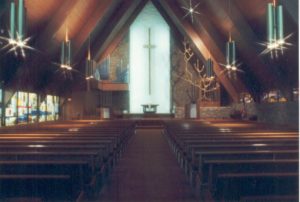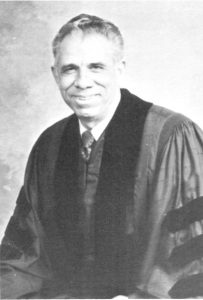1960-1969 Continued
THE FOURTH ERA
The groundbreaking services for this building were held on March 6, 1960. Participating in this service were District Superintendent Forrest Standard; Minister Robert D. Brown; and Assistant Minister Ronald D. Bollinger. This building, which is the north portion of the complex, was completed and consecrated June 1961, and was called the Wesleyan Hall Education Building.
In 1962, a parsonage was purchased at 5120 Blue Ridge Boulevard. The Fellowship Building was sold and moved in March 1963, to make room for the construction of the present sanctuary. This metal building can be seen on the rear parking lot of Christ United Methodist Church in Independence, Missouri, where it is still being used.


As the 1960’s dawned, life was changing rapidly all over the nation. John F. Kennedy was elected President in 1960 and in 1962 John Glenn orbited the Earth three times.
In August of 1963, Martin Luther King gave his “I Have a Dream” speech and by 1968 he had been killed by a lone gunman. On November 22, 1963, John Kennedy was assassinated in Dallas and the Vietnam War began to escalate. Kansas City voters in 1964 approved the admission of minorities to all public places. The decade ended with Neil Armstrong setting foot on the moon on July 20, 1969.
The membership continued to grow. The congregation could no longer be accommodated with the existing facilities. There was a grave need for a new sanctuary. Construction of a new building which would accommodate 575 was started March 1963 and completed February 1964. The cost of the new sanctuary was approximately $250,000.

Bishop Eugene M. Frank, assisted by District Superintendent B. L. Schubel, consecrated this building March 8, 1964. The theme “I AM’ had been chosen to symbolize Christ’s guiding presence in and through the new church: I AM the bread of life; I AM the true vine; I AM the good shepherd; I AM the truth, I AM the meek and lowly of heart; I AM the light of the world; I AM the King; I AM the door and the way; I AM Master and Lord: I AM the resurrection and the life. This Christ-centered spirit pervades the design of the sanctuary from the Crosses of Calvary to the Narthex, to the sanctuary altar. “The Lord hath chosen thee to build a house for the sanctuary; be strong and do it” (1 Chronicles 28:10)

Many memorials and gifts were presented to the church by members through the years. All windows and chancel appointments were given as memorials. With the opening for worship of the new sanctuary in February 1964, the former sanctuary was remodeled to include a chapel, lounge, church school rooms and office.
The Open Door Policy of admitting all persons into membership of the church regardless of racial or ethnic origins was approved by the Official Board, Women’s Society of Christian Service, Wesleyan Service Guild and the Methodist Men in 1964.
A pipe organ costing $18,340.00 was installed in March of 1965 and Mrs. Edna Scotten Billings, noted organist of Kansas City, Missouri, presented an organ recital.
In 1966, Family Life Chairmen Gary and Carolyn Turner attended a conference in Chicago. At that meeting, they learned about a program called Mother’s Day Out that was being tried in many churches. The purpose of MDO was to give mothers of the church and community a day out while their pre-school children were cared for at the church, enjoying creative activities and the fellowship of other children. Under the direction of Louis Buckalew, Minister of Education, and the Education Department, this program was introduced at Blue Ridge in March of 1967. That first year, Mother’s Day Out started with one room and five children who attended one day a week from 10 A.M. to 2 P.M. The program grew rapidly in the coming years under the leadership of Gay Wimmer, Vicky Sibbitt, and Phyllis Ehrhardt. In 1973, Bonnie Downs was hired as Director. She served in that position until 1983. In those years, several rooms were added, the children could attend two times a week, and the teachers were given more training for new ideas. In 1983, Bonnie resigned as Director and Carol Pregge was named in her place. This was a crucial time in the program because as more and more women joined the work force, they needed full-time care for their children. Many wondered if the program could survive. However, with Carol’s hard work and leadership, the program continued to flourish and each year there was a waiting list of parents who wanted their children to be part of this excellent school. In 1990, Mother’s Day Out became Blue Ridge Preschool and Parent’s Day Out. In 1997, PDO received an AT&T grant of $10,000 to purchase needed equipment and to help the church bring the facilities into compliance with new state Child Care Health and Safety Records. In 1995, Karen Warmund was hired as Assistant Director. In 2000, the program had nine rooms with approximately 140 children who were exposed to art, music, and physical education as well as learning and creative activities in the classroom. They attended three days a week from 10 A.M. to 2 P.M.

During the Conference year of 1968, new furnishings were placed in the Chapel. Stained glass windows carry the charge, “To be a good Methodist — to be a good Christian.” Each window on the south side of the Chapel depicts an event in the life of John Wesley; the windows on the west side depict the spirit of Methodism. The windows are all memorials.
On April 23, 1968, the Evangelical United Brethren Church and the Methodist Church were formally united at the Uniting Conference in Dallas, Texas. In Missouri, at Fayette, the Evangelical United Brethren Church, represented by Bishop Paul N. Milhouse and Dr. C. H. Crandall, District Superintendent of the Missouri Conference; and the Methodist Church, represented by Bishop Eugene M. Frank and the Reverend Jeff Marsh, Chairman of the Cabinet for the Missouri West Annual Conference, became one church: The United Methodist Church of Missouri. Our congregation became the Blue Ridge Boulevard United Methodist Church. This was the third time in the over 100 years since 1851 that the name had been changed, but we carry on the mighty witness of God’s love and grace no matter what the name.

Dr. D. Russell Lytle, who had been serving in the Methodist church in Jefferson City, was appointed to Blue Ridge in August of 1968. The following year, Reverend Joe Cooper was named as the Assistant Minister and Maurice Wise as the Director of Education. The north portion of the Education Building was used by the Raytown Schools for Kindergarten classes until 1969. After the school moved out, remodeling was started to convert classrooms into offices in order to have all the church offices centrally located. This was completed in the summer of 1969. When these changes were made, the financial offices were moved to the Education Building which left a vacant room in the Chapel building. With the Church School growing so rapidly, and materials for teachers in demand, there was pressing need for a library. A few books were on a shelf in a classroom, but no plan was in place to organize them in any way. In 1969, Charlotte Robinson went to Joe Cooper and volunteered to be the Church Librarian. With the help of a number of volunteers, shelves were added, books were cataloged, and many children’s books were rescued from cabinets in classrooms. Reverend Nicky Blackford, who was Minister of Education from 1970 to 1972, was instrumental in helping get this project off the ground. Over the years volumes were added from the church budget, donations from the congregation for memorials and honorariums, and purchases by the Women’s Society and church school classes. The library now contains several hundred volumes. In 2000/2001 the room was given a face lift with new paint, rug, and tables and chairs.
